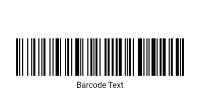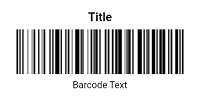The MSI barcode, also known as the Modified Plessey barcode, is a numeric-only barcode symbology developed by the MSI Data Corporation. It was created to improve upon the original Plessey code, primarily for use in inventory management and retail applications. This barcode is known for its simplicity and efficiency in encoding numerical data, making it a popular choice in certain niches.
The MSI barcode originated as an enhancement to the Plessey code, developed in the 1970s by the MSI Data Corporation. The primary goal was to create a more reliable and easily readable barcode symbology. Over the years, the MSI barcode has been widely adopted in various industries, although its use has declined with the advent of more versatile barcode symbologies like Code 128 and QR codes.
Technical Specifications
The MSI barcode is designed to encode numeric data, using digits 0 through 9. It includes a series of bars and spaces of varying widths to represent each digit. The barcode starts and ends with a specific guard pattern, which helps scanners detect the beginning and end of the barcode.
One of the key features of the MSI barcode is its use of a check digit to ensure data integrity. The check digit is calculated using one of several methods, with the most common being the modulo 10 and modulo 11 algorithms.
Modulo 10 Checksum Calculation:
- Starting from the right, double every second digit.
- Sum all the digits, both doubled and undoubled.
- Subtract the sum from the nearest equal or higher multiple of 10.
- The resulting difference is the check digit.
Modulo 11 Checksum Calculation:
- Multiply each digit by a weight, starting from 2 and increasing by 1 for each digit from right to left.
- Sum the products.
- Divide the sum by 11 and use the remainder as the check digit.
Advantages and Disadvantages
The MSI barcode offers several advantages that make it a practical choice for specific applications. Its simplicity is a key benefit, as MSI barcodes are easy to implement and can be efficiently read by basic barcode scanners, making them ideal for scenarios where only numeric data needs to be encoded. Additionally, the inclusion of a check digit helps enhance data integrity by reducing the likelihood of scanning errors. MSI barcodes are also versatile in terms of printing methods; they can be printed using a variety of techniques, including laser and thermal printers, which allows them to be used in diverse environments.
However, MSI barcodes come with some notable disadvantages. They are limited to encoding only numeric data, which restricts their use in applications that require alphanumeric characters or special symbols. Moreover, MSI barcodes are typically larger than other one-dimensional barcodes like Code 128 when encoding the same amount of data, which can be problematic in space-constrained settings. The popularity of MSI barcodes has also declined with the emergence of more versatile and compact barcode symbologies, leading to reduced compatibility and support from modern scanners.
MSI Applications
The MSI barcode is used in a variety of applications, particularly where only numeric data is required. Some common uses include:
- Inventory Control: The MSI barcode is widely used in warehouses and retail stores to manage and track inventory levels efficiently. By encoding product numbers, the barcode facilitates quick scanning and data entry.
- Library Systems: Libraries use MSI barcodes to manage their book inventories and streamline the checkout process. Each book is assigned a unique barcode, allowing for easy tracking of borrowed and returned items.
- Automated Sorting Systems: In logistics and shipping, MSI barcodes are used for sorting packages and parcels. The numeric data encoded in the barcode helps in the automated routing and delivery process.
Comparison with Other Barcode Symbologies
The MSI barcode is particularly useful in specific scenarios but has distinct differences when compared with other common barcode symbologies. For instance, the UPC (Universal Product Code) is predominantly used in retail environments and features a more complex structure for global item identification, unlike the MSI barcode which is limited to numeric characters. Similarly, the EAN (European Article Numbering) system, which is used internationally and includes country-specific prefixes, offers a broader application range than the numeric-only MSI barcode.
On the other hand, Code 39, while more compact and capable of encoding alphanumeric characters, lacks the built-in check digit found in MSI barcodes, potentially impacting data accuracy. Code 128 is known for its compact design and versatility, encoding the full ASCII character set and making it suitable for various applications. This efficiency in space utilization makes Code 128 a more versatile option compared to the MSI barcode.


